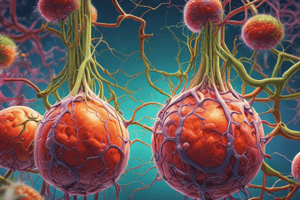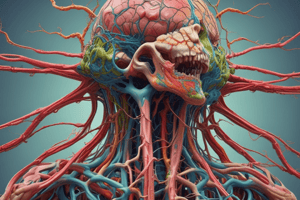Podcast
Questions and Answers
What is the primary difference between primary and secondary lymphatic follicles?
What is the primary difference between primary and secondary lymphatic follicles?
- The exposure to antigen
- The concentration of B-lymphocytes
- The presence of germinal centers (correct)
- The presence of T-lymphocytes
What is the function of the cortical sinuses in the lymph node?
What is the function of the cortical sinuses in the lymph node?
- To filter lymph through the lymph node
- To store lymphocytes and plasma cells
- To produce antibodies against antigens
- To connect the subcapsular and medullary sinuses (correct)
What is the function of the medullary sinuses in the lymph node?
What is the function of the medullary sinuses in the lymph node?
- To filter lymph through the lymph node
- To communicate with efferent vessels (correct)
- To receive lymph from the afferent lymphatic vessels
- To store lymphocytes and plasma cells
What is the main component of the white pulp in the spleen?
What is the main component of the white pulp in the spleen?
What is the structure that conveys blood vessels and nerves in the spleen?
What is the structure that conveys blood vessels and nerves in the spleen?
What is the main difference between the inner cortex and the medulla in the lymph node?
What is the main difference between the inner cortex and the medulla in the lymph node?
What is the purpose of lymph vessels?
What is the purpose of lymph vessels?
What is the main component of lymphatic tissues?
What is the main component of lymphatic tissues?
Which of the following is a non-capsulated lymphoid organ?
Which of the following is a non-capsulated lymphoid organ?
What is the structure of a lymph node?
What is the structure of a lymph node?
What is the function of the stroma in a lymph node?
What is the function of the stroma in a lymph node?
What is the outer cortex of a lymph node composed of?
What is the outer cortex of a lymph node composed of?
Flashcards are hidden until you start studying
Study Notes
Lymphatic Follicles
- Primary lymphatic follicles: not exposed to antigen, contain B-lymphocytes, no germinal centers
- Secondary lymphatic follicle: exposed to antigen, central area becomes paler, contains activated B-lymphocytes with pale nuclei, germinal center present
Inner Cortex (Para Cortex)
- Located between outer cortex and medulla
- Contains high concentration of T-lymphocytes derived from the thymus, considered thymus-dependent area
- Cortical sinuses: irregular spaces lined by endothelial cells, of two types - subcapsular and paratrabecular (intermediate)
Medulla
- Consists of medullary cords and medullary sinuses
- Medullary cords: cord-like extensions of cortical lymphoid tissue, composed of lymphocytes and plasma cells
- Medullary sinuses: receive lymph from cortical sinuses, communicate with efferent vessels, lymph leaves the node through them
Lymph Node Functions
- Immunologic reaction, both cellular and humoral
- Filtration of lymph
- Lymph movement through the node is unidirectional due to presence of valves in afferent and efferent lymphatic vessels
The Spleen
- Largest lymphatic organ in the body
- Structure: composed of stroma and parenchyma
- Stroma: composed of capsule, trabeculae, and reticular network
- Parenchyma: composed of red pulp and white pulp
- White pulp: composed of lymphatic follicles, periarterial lymphatic sheaths (PALs), and central artery
- Red pulp: dark red tissue, contains splenic cords and splenic sinuses
Lymphatic System
- Consists of lymph vessels and lymphatic tissues
- Lymphatic vessels: carry lymph from interstitial spaces to blood, have same structure as blood vessels, but with larger diameter and one blind end
- Lymphatic tissues: contain aggregates of lymphocytes embedded in a network of reticular fibers
Lymphoid Organs
- Classified into: capsulated (thymus, lymph nodes, and spleen) and non-capsulated (tonsils, Peyer's patches, lymphatic nodules)
- Lymph nodes: encapsulated spherical or kidney-shaped organs, distributed along the course of lymphatic vessels
Studying That Suits You
Use AI to generate personalized quizzes and flashcards to suit your learning preferences.




